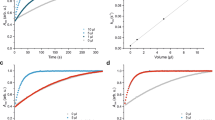Abstract
Plant pathogenic fungi secrete several non-catalytic proteins involved in various aspects of the pathogenesis process. Amongst these, cerato-populin (Pop1) produced by Ceratocystis populicola; a protein orthologous of cerato-platanin (CP), the core member of the CP family. These two proteins interact with host and non-host plants. In plane leaves they induce synthesis of phytoalexins, disruption of intercellular and intracellular leaf tissue, cell plasmolysis, programmed cell death, over-expression of defence-related genes, H2O2 and NO production, activation of MAPK cascade and plant resistance. All these features point to CP and Pop1 as defence inducers, though Pop1 shows a reduced efficiency. Pop1/CP similarity is 73 %. CD spectroscopy highlights some secondary structure differences between Pop1 and CP. Indeed, the region between the first two cysteines (C20–C57), that in CP includes the β2-strand and it is involved in GlcNAc (N-acetyl-d-glucosamine) interaction, in Pop1 is predicted to be fully disordered.

Similar content being viewed by others
Notes
GRAVY: Grand average hydropathicity index, an indication of the solubility of proteins (Kyte and Doolittle, 1982).
References
Comparini C, Carresi L, Pagni E, Sbrana F, Sebastiani F, Luchi N, Santini A, Capretti P, Tiribilli B, Pazzagli L, Cappugi G, Scala A (2009) New proteins orthologous to cerato-platanin in various Ceratocystis species and the purification and characterization of cerato-populin from Ceratocystis populicola. Appl Microbiol Biotechnol 84:309–322
de Oliveira A, Gallo M, Pazzagli L, Benedetti CE, Cappugi G, Scala A, Pantera B, Spisni A, Pertinhez TA, Cicero DO (2011) The structure of the elicitor Cerato-platanin (CP), the first member of the CP fungal protein family, reveals a double ψβ-barrel fold and carbohydrate binding. J Biol Chem 286:17560–17568
Delaglio F, Grzesiek S, Vuister GW, Zhu G, Pfeifer J, Bax A (1995) NMRPipe: a multidimensional spectral processing system based on UNIX pipes. J Biomol NMR 6:277–293
Djonović S, Pozo MJ, Dangott LJ, Howell CR, Kenerley CM (2006) Sm1, a proteinaceous elicitor secreted by the biocontrol fungus Trichoderma virens induces plant defense responses and systemic resistance. Mol Plant Microbe Interact 19:838–853
Dodds PN, Rathjen JP (2010) Plant immunity: towards an integrated view of plant-pathogen interactions. Nat Rev Genet 11:539–548
Frias M, Brito N, Gonzales C (2013) The Botrytis cinerea cerato-platanin BcSpl1 is a potent inducer of systemic acquired resistance (SAR) in tobacco and generates a wave of salicylic acid expanding from the site of application. Mol Plant Pathol 14:191–196
Frischmann A, Neudl S, Gaderer R, Bonazza K, Zach S, Gruber S, Spadiut O, Friedbacher G, Grothe H, Seidl-Seiboth V (2013) Self-assembly at air/water interfaces and carbohydrate-binding properties of the small secreted protein EPL1 from the fungus Trichoderma atroviride. J Biol Chem 288:4278–4287
Johnson BA, Blevins RA (1994) NMRView: a computer program for the visualization and analysis of NMR data. J Biomol NMR 4:603–614
Jones JDG, Dangl JL (2006) The plant immune system. Nature 444:323–329
Kyte J, Doolittle RF (1982) A simple method for displaying the hydropathic character of a protein. J Mol Biol 157:105–132
Lombardi L, Faoro F, Luti S, Baccelli I, Martellini F, Bernardi R, Picciarelli P, Scala A, Pazzagli L (2013) Differential timing of defense-related responses induced by cerato-platanin and cerato-populin, two non-catalytic fungal elicitors. Physiol Plant. doi:10.1111/ppl.12041
Martellini F, Faoro F, Carresi L, Pantera B, Baccelli I, Maffi D, Tiribilli B, Sbrana F, Luti S, Comparini C, Bernardi R, Cappugi G, Scala A, Pazzagli L (2013) Cerato-populin and cerato-platanin, two non-catalytic proteins from phytopathogenic fungi, interact with hydrophobic inanimate surfaces and leaves. Mol Biotechnol 55:27–42
Pazzagli L, Cappugi G, Manao G, Camici G, Santini A, Scala A (1999) Purification, characterization, and amino acid sequence of cerato-platanin, a new phytotoxic protein from Ceratocystis fimbriata f. sp. platani. J Biol Chem 274:24959–24964
Zaparoli G, Cabrera OG, Medrano FJ, Tiburci R, Lacerda G, Guimarães Pereira G (2009) Identification of a second family of genes in Moniliophthora perniciosa, the causal agent of witches broom disease in cacao, encoding necrosis-inducing proteins similar to cerato-platanins. Mycol Res 113:61–72
Acknowledgments
This work was partly supported by PRIN 2009, Italy.
Author information
Authors and Affiliations
Corresponding author
Rights and permissions
About this article
Cite this article
Baroni, F., Pazzagli, L., Luti, S. et al. 1H, 15N and 13C resonance assignment of cerato-populin, a fungal PAMP from Ceratocystis populicola . Biomol NMR Assign 8, 405–408 (2014). https://doi.org/10.1007/s12104-013-9527-x
Received:
Accepted:
Published:
Issue Date:
DOI: https://doi.org/10.1007/s12104-013-9527-x




